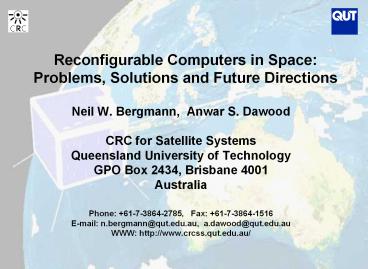Reconfigurable Computers in Space: Problems, Solutions and Future Directions - PowerPoint PPT Presentation
Title:
Reconfigurable Computers in Space: Problems, Solutions and Future Directions
Description:
Reconfigurable Computers in Space: Problems, Solutions and Future Directions Neil W. Bergmann, Anwar S. Dawood CRC for Satellite Systems Queensland University of ... – PowerPoint PPT presentation
Number of Views:79
Avg rating:3.0/5.0
Title: Reconfigurable Computers in Space: Problems, Solutions and Future Directions
1
Reconfigurable Computers in Space Problems,
Solutions and Future Directions
- Neil W. Bergmann, Anwar S. DawoodCRC for
Satellite SystemsQueensland University of
TechnologyGPO Box 2434, Brisbane 4001Australia - Phone 61-7-3864-2785, Fax 61-7-3864-1516
E-mail n.bergmann_at_qut.edu.au,
a.dawood_at_qut.edu.auWWW http//www.crcss.qut.edu.
au/
2
Summary
- Interest in Reconfigurable Computing (RC) has
recently spread to those interested in space
missions. - Although RC has sparked much interest in the
general computing community, it has yet to
demonstrate killer app status for any
terrestrial applications. - However, we believe that there are several
compelling arguments about why RC is an excellent
match to the requirements of space missions. - This paper
- Describes these arguments,
- Looks at characteristics of the space
environment, - Looks at possible solutions to the use of RC in
space, and - Looks at possible long-term research directions.
3
Why can space be a killer app for
Reconfigurable Computing?
- After launch, unmanned spacecraft electronics are
generally unavailable for physical upgrade or
repair. RC technology allows new hardware
circuits to be uploaded via a radio link. - New circuit configurations can overcome design
faults, allow improved processing algorithms to
be uploaded, or change system functionality in
response to changing mission requirements. - The same circuitry can be used with different
configurations at different stages of a mission,
reducing weight and power requirements. - If part of an FPGA fails, then circuitry can be
reprogrammed to make use of remaining functional
portions of the chips. - Use of FPGAs allows generic circuit boards to be
designed, which are customised for individual
applications. This helps overcome the very high
NRE costs associated with small volume spacecraft
design. Physical and environmental qualification
costs can also be shared across many missions. - In-flight reconfiguration provides additional
safety margins for missions with very short
lead-times, or for those where mission
requirements are not fullt defined at launch.
4
Problematic Aspects of Operating in Space
- Ionising radiation causes soft-errors in the
static RAM cells used to hold programming
information in FPGAs.Longer-term ionising
radiation causes hard-errors in the electronic
circuitry. - Radio-links to spacecraft are often low bandwidth
and high error-rate. This is not a good match to
the relatively large configuration files of order
1 Mbit required for modern FPGAs. - Limited on-board memory restricts the number of
different configurations that can be stored.
Uploaded alternative configurations stored in
EEPROM are also susceptible to radiation-induced
errors.
5
Short-term solutions for configuration errors
- FPGAs generally allow the configuration
bit-stream to be read back to check for errors.
The simplest FPGA-configuration error-detection
technique simply examines the readback bitstream
and compares it to the correct bitstream (or
alternatively compares the CRC signature of the
read-back stream to the desired). Correction is
by reloading the FPGA configuration. - Triple-redundancy voting circuits allow faulty
FPGA circuits to be switched out and reprogrammed
while the system is still operating.
6
Short-term solutions for configuration management
- Techniques to assist with uploading new
configurations aim to reduce configuration file
sizes for storage and transmission. - Techniques include specialised compression
techniques, and differential configuration
formats (relative to an on-board default
configuration). - CRC checks are necessary for on-board monitoring
of configuration file integrity. - For deep space missions, error correcting codes
are desirable.
7
Long-term solutions requiring special
space-friendly FPGAs
- Space-friendly FPGAs should provide on-chip
configuration error-detection and/or correction
circuitry which operates continuously and
unobtrusively. - Techniques will need to be developed to identify
permanently faulty logic blocks within an FPGA,
most likely by loading a special set of
diagnostic configurations. - Techniques are needed to allow existing circuit
designs to be reconfigured on-board the
spacecraft to avoid faulty logic cells. This is
impractical with current generation
place-and-route software. - There is much scope for research into
error-detecting or fault-secure logic circuit
designs for FPGAs, based on a new single
configuration bit-flip error model. These
internally redundant logic gate designs could
build strong fault tolerance into existing FPGA
chips. - A single chip or MCM combination of FPGA,
microcontroller, flash memory configuration
store, and digital and analog I/O circuitry would
greatly reduce space mission weight and cost.
8
Adaptive Instrument Module Payload
- This is being designed for the experimental
FedSat LEO, due for launch in late 2001. - This experiment provides a vehicle for validating
our research ideas. - A small (1kg) payload consisting of
- Microcontroller with RS422 communications
- SRAM-based FPGA (Xilinx X4062)
- RAM, PROM, Flash Memory storage
- Adaptive Instrument Port
9
Conclusions
- Reconfigurable computing has many advantages for
space applications, and is an excellent match to
new directions in low-cost, flexible space
missions. - Existing FPGA architectures have significant
operational issues (eg radiation induced errors)
and management issues (such as configuration
management). - In the short term these issues can be identified
and ameliorated by additional external circuit
and system techniques - In the long-term, these techniques need to be
included as part of the FPGA chip design. - Overall, there is potential for space-based
computing to be a killer app for reconfigurable
computing technology.































